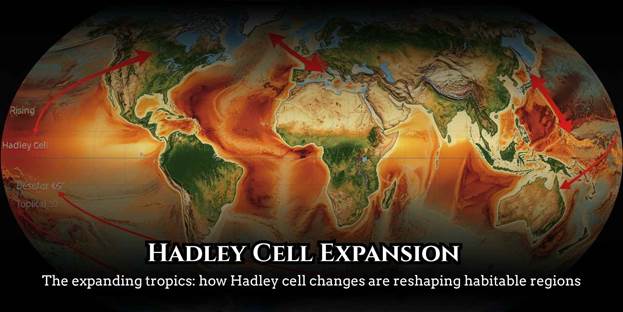The Hadley Cell Expansion refers to the widening of the Earth’s tropical atmospheric circulation, where warm air rises near the equator and descends around 30 degrees latitude. Traditionally, this circulation determines the location of tropical rain belts and arid desert zones. However, recent studies reveal that the Hadley Cell has been expanding toward the poles by 0.5 to 1 degree per decade, reshaping global climate zones.
Table of Contents
This phenomenon affects the balance between humid and dry regions, leading to shifting rainfall patterns and altering habitable zones. As a result, regions once suitable for agriculture and settlement are becoming drier, while other areas are facing unexpected rainfall. Understanding Hadley Cell Expansion is crucial to predicting future changes in climate, ecosystems, and human living conditions.

Definition and Mechanism of Hadley Cell Expansion
The Hadley Cell is part of a global atmospheric circulation pattern that transports heat and moisture from the equator toward higher latitudes. It consists of three main steps:
- Air moves poleward in the upper atmosphere, cools, and sinks around 30° latitude.
- Cool air returns to the equator at the surface, completing the cycle.
The Hadley Cell Expansion occurs when this circulation pushes farther poleward, extending the boundaries of dry subtropical zones. This shift is linked to global warming, greenhouse gas emissions, and changes in oceanic and atmospheric temperatures. Scientists use satellite data and climate models to track this expansion, confirming its consistent trend since the late 20th century.
Historical Context and Scientific Observations
Historically, the Hadley Cell was believed to be stable over long timescales. However, post-1979 satellite data from NASA and NOAA show clear evidence of poleward movement in the tropical circulation boundaries. Researchers have observed that:
- The Northern Hemisphere Hadley Cell is expanding faster than the Southern Hemisphere’s.
- Ozone depletion in the stratosphere contributes to the shift in circulation.
- Increased greenhouse gases intensify warming at tropical latitudes, expanding the cell outward.
This pattern mirrors long-term climate records suggesting that during past warming periods, such as the mid-Holocene, similar expansions occurred.
Impacts of Hadley Cell Expansion on Global Climate Zones
The widening of the Hadley Cell significantly alters global weather systems. As tropical regions expand, arid zones move poleward, affecting rainfall, ecosystems, and agriculture.
1. Shifting Deserts and Rainfall Patterns
Regions that were once semi-arid are turning into deserts. For example:
- The Mediterranean Basin is drying rapidly, resembling desert-like climates.
- Southern Australia and the American Southwest are experiencing long-term droughts.
- Rain belts near the equator, such as the Intertropical Convergence Zone (ITCZ), are shifting, leading to erratic rainfall in tropical regions.
2. Changes in Habitable Land
As Hadley Cell Expansion progresses, habitable zones suitable for farming and settlement shrink in some areas while expanding in others.
- Agricultural stress increases in regions that depend on predictable rainfall.
- Tropical diseases may spread into new regions as warm, humid conditions move north and south.
- Population migration may rise as people leave drought-prone areas.
Environmental and Socioeconomic Consequences
The Hadley Cell Expansion does not just alter weather; it transforms entire ecosystems and economies.
- Ecosystem Shifts: Tropical and subtropical ecosystems are adapting or collapsing. Grasslands may replace forests in marginal zones.
- Water Scarcity: Expanding dry regions mean less rainfall, leading to reduced groundwater recharge.
- Agricultural Losses: Crops that rely on steady moisture, like wheat and maize, face declining yields.
- Extreme Weather: Expanding tropics may contribute to stronger hurricanes and unpredictable monsoon seasons.
These effects threaten food security, biodiversity, and economic stability, especially in developing nations within the tropics and subtropics.
Scientific Debates and Challenges
While the Hadley Cell Expansion is widely accepted, scientists continue to debate its rate, causes, and long-term implications. Some key questions remain:
- Is the expansion driven more by greenhouse gases or ozone depletion?
- Will the expansion stabilize if global emissions decline?
- How will feedback loops in the Earth’s climate system amplify or dampen the process?
Climate models predict continued expansion through the 21st century if warming trends persist. This raises urgent concerns about climate resilience and adaptation for vulnerable regions.

Real-World Examples and Case Studies
Evidence of Hadley Cell Expansion can be observed globally:
- Australia: The southern shift of rain belts has reduced winter precipitation, intensifying wildfires and droughts.
- Africa: The Sahel region faces recurring droughts as the northern limit of tropical rainfall retreats.
- North America: Southwestern states like Arizona and New Mexico are becoming more arid, resembling desert climates.
- Mediterranean Europe: Increasing dryness and heatwaves align with predicted Hadley Cell shifts.
These real-world examples show that the Hadley Cell Expansion is not an abstract theory but a measurable, ongoing transformation.
Adapting to the Expanding Tropics
Addressing the consequences of Hadley Cell Expansion requires global collaboration and sustainable adaptation strategies:
- Promote Climate-Resilient Agriculture such as drought-tolerant crops.
- Invest in Water Management through rainwater harvesting and efficient irrigation.
- Strengthen Reforestation Efforts to restore local moisture cycles.
- Reduce Greenhouse Gas Emissions to slow global warming and stabilize atmospheric circulation.
Communities and governments must work together to anticipate climate shifts and safeguard livelihoods.
Conclusion
The Hadley Cell Expansion is reshaping Earth’s habitable zones, influencing rainfall, agriculture, and ecosystems. As the tropics widen, arid zones expand and previously fertile regions face new challenges. Understanding and addressing this shift is essential to adapt to a changing climate. By reducing emissions, conserving ecosystems, and embracing innovation, humanity can mitigate the impact of this expanding tropical boundary and preserve balance in our planet’s climate system.
Q1: What is Hadley Cell Expansion?
Hadley Cell Expansion is the poleward widening of Earth’s tropical circulation, shifting dry and wet zones globally.
Q2: What causes Hadley Cell Expansion?
It is primarily caused by global warming, ozone depletion, and increasing greenhouse gas concentrations.